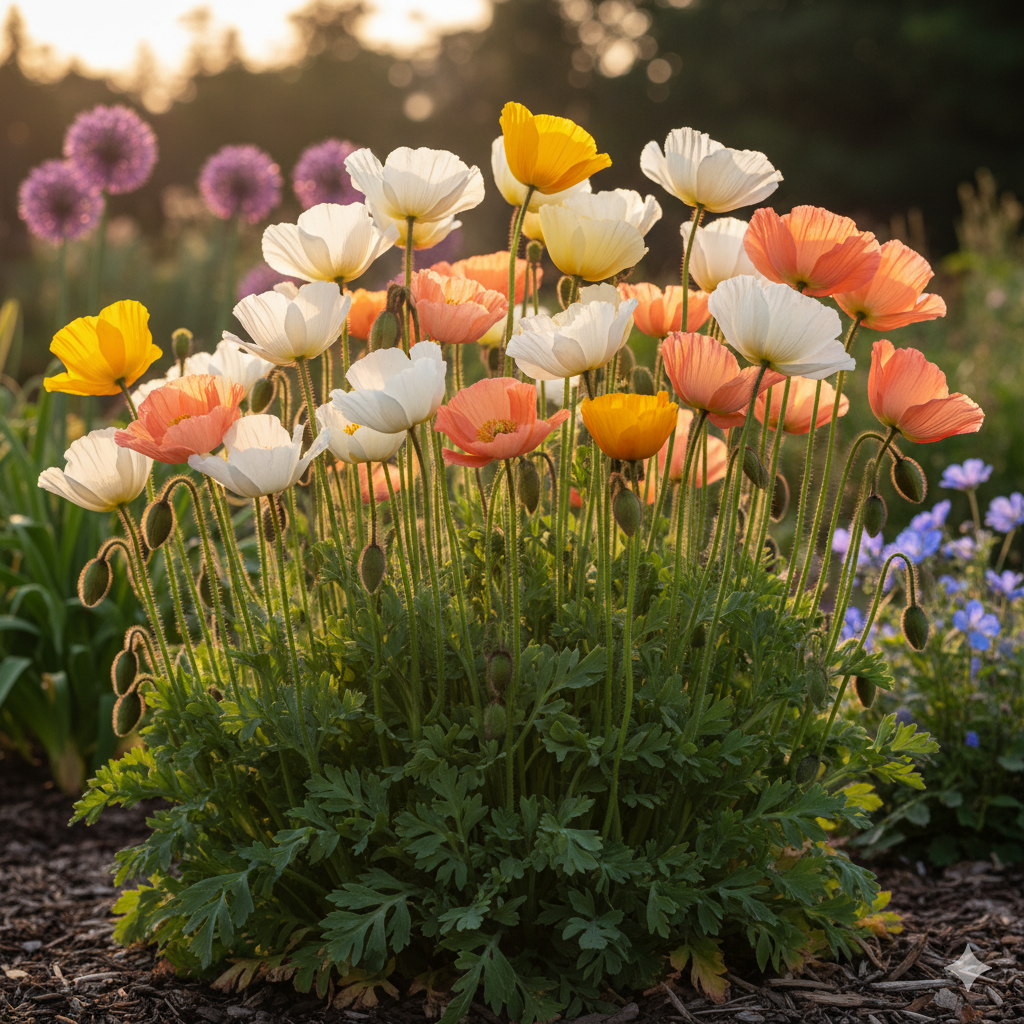Introduction
Captivating gardeners worldwide, the Icelandic poppies (Papaver nudicaule) shines with delicate, luminous petals and vivid colors. Though associated with Iceland, these enchanting flowers actually hail from subarctic regions across Asia and North America, making them a must-have highlight for cool-climate gardens. Known for hardiness yet refined beauty, Iceland poppies offer unmatched appeal from late spring into summer and serve as one of the best cut flowers for lasting, cheerful bouquets.
🌱Quick Start Icelandic Poppy Checklist
-
Climate: Thrives in USDA zones 2–8, cooler is better
-
Soil: Light, sandy, well-drained—no clay or heavy compost
-
Sun: Full sun (at least 6 hours/day)
-
Sowing: Surface-sow seeds, indoors 8–12 weeks before last frost or outside fall/early spring; needs light to germinate
-
Water: Keep soil evenly moist but never soggy
-
Deadheading: Remove spent blooms regularly
-
Dormancy: Allow plants to rest if heat exceeds 70°F (21°C)
-
Vase Life: Harvest at cracking bud stage, briefly sear stem ends with heat for up to a week of vase freshness
 What Makes Icelandic Poppies Unique?
What Makes Icelandic Poppies Unique?
| Feature | Details |
|---|---|
| Scientific Name | Papaver nudicaule |
| Common Names | Iceland Poppies, Arctic Poppy, Siberian Poppy |
| Native Range | Subarctic Asia & North America |
| Growth Habit | Short-lived perennial (grown as biennial/annual) |
| Height/Spread | 12–24 inches |
| Bloom Season | Late spring–early summer |
| Colors | Cream, white, yellow, pink, red, apricot, salmon |
| Foliage | Soft, hairy, green basal leaves |
Why the “Icelandic” misnomer?
Botanists named these poppies after observing their performance in arctic climates near Iceland, though they never evolved there directly.
How to Grow Icelandic Poppies
Choosing the Right Location & Soil
-
Select a spot with full sun; poppies bloom best with at least 6 hours of direct sunlight.
-
Use a sandy or gritty soil that drains extremely well. Avoid heavy compost or clay mixes, as these increase risk of damping off and root rot.
-
Slightly acidic to neutral pH (6.0–7.5) is ideal.
Sowing and Starting Seeds
-
Indoors: Begin seeds in cell trays 8–12 weeks before last frost. Seeds should be sown on the soil surface and never covered, as light is crucial for germination.
-
Outdoors: Direct sow in early spring, late fall, or whenever nighttime temperatures are below 60°F (15°C).
-
Thin seedlings to 6–12 inches apart to improve airflow and reduce fungal risks.
Care, Fertilizer, and Maintenance
-
Water: Keep soil evenly moist, watering less frequently but deeply; avoid wetting leaves or letting the soil remain waterlogged.
-
Fertilizer: Apply only a diluted, balanced feed in early spring—excess nitrogen encourages leaf growth, not flowers.
-
Mulch: A light topdressing helps retain moisture and keeps roots cool.
-
Deadheading: Snip spent blooms quickly; this promotes a continuous display.
-
Dormancy: If heat spikes above 70°F (21°C), don’t worry if foliage goes dormant. This is natural.
Icelandic Poppies vs Other Poppies
| Feature | Icelandic Poppies | Oriental Poppy | Shirley Poppy |
|---|---|---|---|
| Bloom Time | Late spring–early summer | Late spring–early summer | Spring–early summer |
| Lifespan | Short-lived perennial | Long-lived perennial | Annual |
| Colors | Yellow, salmon, cream, etc | Red, pink, orange mostly | Red, pink, white |
| Hardiness | USDA 2–8 | USDA 3–7 | USDA 6–9 |
| Use | Cool-climate, cut flower | Borders | Wildflower mixes |
Landscape Uses and Arranging Tips
-
Best Garden Uses: Cottage garden borders, alpine beds, rock gardens, or mass plantings for color.
-
Great Companions: Plant alongside tulips, alliums, hardy geraniums, and daffodils for continuous spring interest.
-
Cut Flower Secret: For bouquets that last, cut flower stems when buds just begin to crack open. Sear the end of each stem with hot water or a flame to seal in the sap and moisture.
Common Issues and Troubleshooting
-
Aphids: Remove with a strong jet of water or treat with insecticidal soap if infestations persist.
-
Fungal Diseases: Prevent by ensuring good air circulation, keeping leaves dry, and using soil-less starting mixes.
-
Root Rot: Always linked to poor drainage—if in doubt, amend soil with sand or grit.
-
Heat Stress: High temperatures trigger summer dormancy or plant dieback; this is a natural response for arctic-adapted species.
-
Toxicity Warning: Iceland poppies are toxic to humans and pets if ingested—always handle with care and keep away from curious animals.
Icelandic Poppies FAQ
Are Icelandic poppies easy to grow?
Yes, with the right environment: cool weather, full sun, and well-drained soil.
Do they return every year?
In cold climates (zones 2–5) they can persist as short-lived perennials. In warmer areas, consider them as annuals, though they may self-seed.
When should seeds be sown?
In cool climates: late summer/fall for spring blooms. In warmer zones: indoors before last frost, or direct sow very early spring.
Why do plants die in summer?
Temperatures above 70°F (21°C) push them into summer dormancy—a survival tactic, not a failure.
How to keep cut flowers fresh?
Cut at the cracking bud stage and immediately sear stems to prevent sap loss, extending vase life to 7 days.
Conclusion
The Icelandic poppies is a jewel for temperate gardens, valued for its delicate looks and robust nature. Give it sun, sharp drainage, and let it rest in the heat, and these poppies will reward with glowing color and superb cut flowers, season after season.
For more growing and care guidance, visit:
Royal Horticultural Society (RHS)
USDA Plants Database

